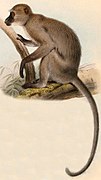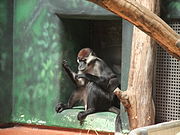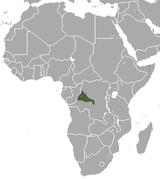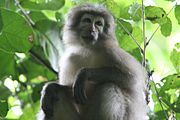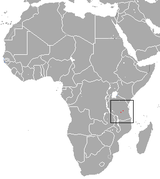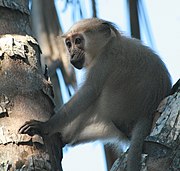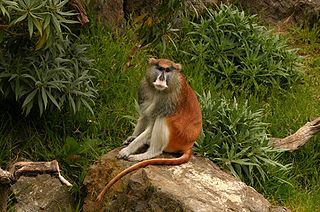
Erythrocebus is a genus of Old World monkey. All three species in this genus are found in Africa, and are known as patas monkeys. While previously considered a monotypic genus containing just E. patas, a 2017 review argued that, based on morphological evidence and heavy geographic separation between taxa, E. patas should be split back into distinct species as recognised in the 19th century.

The needle-clawed bushbabies are the two species in the genus Euoticus, which is in the family Galagidae. Galagidae is sometimes included as a subfamily within the Lorisidae.

The guenons are Old World monkeys of the genus Cercopithecus. Not all members of this genus have the word "guenon" in their common names; also, because of changes in scientific classification, some monkeys in other genera may have common names that include the word "guenon". Nonetheless, the use of the term guenon for monkeys of this genus is widely accepted.

The golden-bellied mangabey is a social Old World monkey found in swampy, humid forests south of the Congo River in the Democratic Republic of the Congo. It was previously considered a subspecies of the agile mangabey . Little is published about the species and its behaviour has only been studied in captivity.

Mangabeys are West African Old World monkeys, with species in three of the six genera of tribe Papionini.

The kipunji, also known as the highland mangabey, is a species of Old World monkey that lives in the highland forests of Tanzania. The kipunji has a unique call, described as a 'honk-bark', which distinguishes it from its relatives, the grey-cheeked mangabey and the black crested mangabey, whose calls are described as 'whoop-gobbles'.

The sooty mangabey is an Old World monkey found in forests from Senegal in a margin along the coast down to the Ivory Coast.
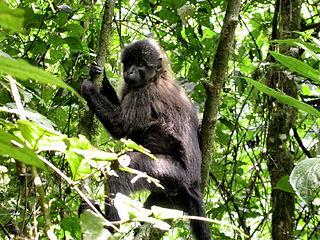
The Uganda mangabey is a species of Old World monkey found only in Uganda and in the Minziro Forest Reserve, just over the border in Tanzania. This crested mangabey was previously thought to just be a population of the grey-cheeked mangabey. Colin Groves upgraded the Ugandan population to the new species L. ugandae on 16 February 2007. This species is significantly smaller than the grey-cheeked mangabey, with a shorter skull and smaller face. 2008 was the most recent year in which the International Union for Conservation of Nature assessed the conservation status of L. albigena, describing it as being of least concern, and the status of L. ugandae has not been assessed separately.

The collared mangabey, also called red-capped mangabey and white-collared mangabey is a species of primate in the family Cercopithecidae of Old World monkeys. It formerly included the sooty mangabey as a subspecies. As presently defined, the collared mangabey is monotypic.

The agile mangabey is an Old World monkey of the white-eyelid mangabey group found in swampy forests of Central Africa in Equatorial Guinea, Cameroon, Gabon, Central African Republic, Republic of Congo, and DR Congo. Until 1978, it was considered a subspecies of the Tana River mangabey. More recently, the golden-bellied mangabey has been considered a separate species instead of a subspecies of the agile mangabey.

The Sanje mangabey is a highly endangered Old World monkey of the white-eyelid mangabey group from the Eastern Arc Mountains in Tanzania. They are about 50–65 centimetres (20–26 in) in length, excluding the tail, and their body colour is greyish. Fruit makes up about 70% of their diet. They live in valley forests and on mountain slopes, but are mostly ground-dwelling, which makes them susceptible to hunting and poaching. Their habitat is being degraded, and the International Union for Conservation of Nature has assessed their conservation status as being "endangered".
Johnston's mangabey is a species of crested mangabey in the family Cercopithecidae. It had been considered a subspecies of the gray-cheeked mangabey, but was elevated to species Level in 2007, alongside Osman Hill's mangabey and the Uganda mangabey.

The Osman Hill's mangabey, also known as the rusty-mantled mangabey, is a species of crested mangabey in the family Cercopithecidae with a restricted distribution in West Africa.

Allochrocebus is a primate genus including the terrestrial guenons: the L'Hoest's monkey, the Preuss's monkey, and the sun-tailed monkey.

The squirrel galagos are a group of four species of strepsirrhine primates. They are classified in the genus Sciurocheirus of the family Galagidae.
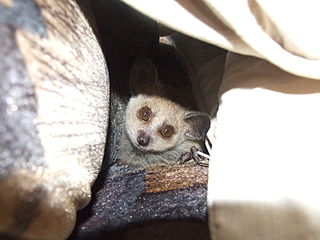
The eastern dwarf galagos are a group of five species of strepsirrhine primates of the family Galagidae, native to East Africa. They were formerly classified in the genus Galagoides but have been moved to their own genus, Paragalago, based on genetic evidence, and supported by differences in vocalizations and morphology. The three western/Congolian species remain in Galagoides.

The white-naped mangabey is a species of Old World monkey in the subfamily Cercopithecinae. The species is found in the forest of Burkina Faso, Ghana and Ivory Coast. The species population has been declining due to deforestation and hunting and has thus been put as an endangered species by the International Union for Conservation of Nature. The species was once considered a subspecies of the sooty mangabey but is now a separate species. This species had previously been regarded as a subspecies of Cercocebus atys, but was later raised to species status.

